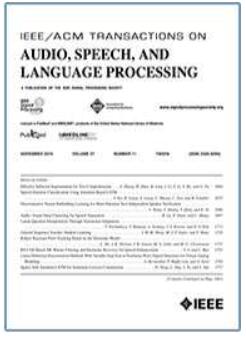SpeechPrompt:提示语音语言模型完成语音处理任务
IF 5.1
2区 计算机科学
Q1 ACOUSTICS
IEEE/ACM Transactions on Audio, Speech, and Language Processing
Pub Date : 2024-08-02
DOI:10.1109/TASLP.2024.3436618
引用次数: 0
摘要
提示已成为利用预训练语言模型(LM)的一种实用方法。这种方法有几个优点。它能让 LM 以最少的训练和参数更新适应新任务,从而实现存储和计算的高效率。此外,提示只修改 LM 的输入,并利用语言模型的生成能力,以统一的方式处理各种下游任务。这大大减少了设计特定任务模型的人力需求。随着语言模型所服务任务数量的增加,这些优势会变得更加明显。在提示功能优势的推动下,我们首次探索了提示语音 LM 在语音处理领域的潜力。最近,人们对将语音转换为离散单元进行语言建模的兴趣日益浓厚。我们的开创性研究表明,在我们的统一提示框架内,这些量化语音单元具有很强的通用性。它们不仅可以作为类标签,还包含丰富的语音信息,可以重新合成为语音信号,用于语音生成任务。具体来说,我们将语音处理任务重新表述为语音单元生成任务。因此,我们可以在一个统一的提示框架内无缝整合语音分类、序列生成和语音生成等任务。实验结果表明,在可训练参数数量相近的情况下,与基于自监督学习模型的强微调方法相比,提示方法可以获得具有竞争力的性能。提示法还在少镜头设置中显示出良好的效果。此外,随着先进的语音 LM 进入舞台,所提出的提示框架将大有可为。本文章由计算机程序翻译,如有差异,请以英文原文为准。
SpeechPrompt: Prompting Speech Language Models for Speech Processing Tasks
Prompting has become a practical method for utilizing pre-trained language models (LMs). This approach offers several advantages. It allows an LM to adapt to new tasks with minimal training and parameter updates, thus achieving efficiency in both storage and computation. Additionally, prompting modifies only the LM's inputs and harnesses the generative capabilities of language models to address various downstream tasks in a unified manner. This significantly reduces the need for human labor in designing task-specific models. These advantages become even more evident as the number of tasks served by the LM scales up. Motivated by the strengths of prompting, we are the first to explore the potential of prompting speech LMs in the domain of speech processing. Recently, there has been a growing interest in converting speech into discrete units for language modeling. Our pioneer research demonstrates that these quantized speech units are highly versatile within our unified prompting framework. Not only can they serve as class labels, but they also contain rich phonetic information that can be re-synthesized back into speech signals for speech generation tasks. Specifically, we reformulate speech processing tasks into speech-to-unit generation tasks. As a result, we can seamlessly integrate tasks such as speech classification, sequence generation, and speech generation within a single, unified prompting framework. The experiment results show that the prompting method can achieve competitive performance compared to the strong fine-tuning method based on self-supervised learning models with a similar number of trainable parameters. The prompting method also shows promising results in the few-shot setting. Moreover, with the advanced speech LMs coming into the stage, the proposed prompting framework attains great potential.
求助全文
通过发布文献求助,成功后即可免费获取论文全文。
去求助
来源期刊

IEEE/ACM Transactions on Audio, Speech, and Language Processing
ACOUSTICS-ENGINEERING, ELECTRICAL & ELECTRONIC
CiteScore
11.30
自引率
11.10%
发文量
217
期刊介绍:
The IEEE/ACM Transactions on Audio, Speech, and Language Processing covers audio, speech and language processing and the sciences that support them. In audio processing: transducers, room acoustics, active sound control, human audition, analysis/synthesis/coding of music, and consumer audio. In speech processing: areas such as speech analysis, synthesis, coding, speech and speaker recognition, speech production and perception, and speech enhancement. In language processing: speech and text analysis, understanding, generation, dialog management, translation, summarization, question answering and document indexing and retrieval, as well as general language modeling.
 求助内容:
求助内容: 应助结果提醒方式:
应助结果提醒方式:


